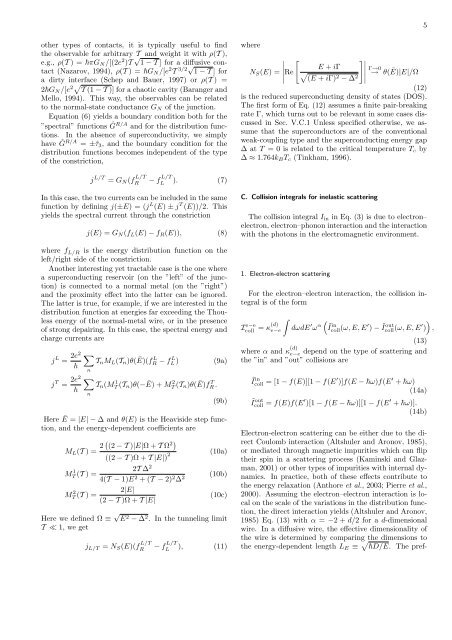Thermal properties in mesoscopics: physics and ... - ResearchGate
Thermal properties in mesoscopics: physics and ... - ResearchGate
Thermal properties in mesoscopics: physics and ... - ResearchGate
You also want an ePaper? Increase the reach of your titles
YUMPU automatically turns print PDFs into web optimized ePapers that Google loves.
other types of contacts, it is typically useful to f<strong>in</strong>d<br />
the observable for arbitrary T <strong>and</strong> weight it with ρ(T ),<br />
e.g., ρ(T ) = πGN /[(2e 2 )T √ 1 − T ] for a diffusive contact<br />
(Nazarov, 1994), ρ(T ) = GN /[e 2 T 3/2√ 1 − T ] for<br />
a dirty <strong>in</strong>terface (Schep <strong>and</strong> Bauer, 1997) or ρ(T ) =<br />
2GN/[e 2 T (1 − T )] for a chaotic cavity (Baranger <strong>and</strong><br />
Mello, 1994). This way, the observables can be related<br />
to the normal-state conductance GN of the junction.<br />
Equation (6) yields a boundary condition both for the<br />
”spectral” functions ˆ G R/A <strong>and</strong> for the distribution functions.<br />
In the absence of superconductivity, we simply<br />
have ˆ G R/A = ±ˆτ3, <strong>and</strong> the boundary condition for the<br />
distribution functions becomes <strong>in</strong>dependent of the type<br />
of the constriction,<br />
j L/T = GN (f L/T<br />
R<br />
L/T<br />
− fL ). (7)<br />
In this case, the two currents can be <strong>in</strong>cluded <strong>in</strong> the same<br />
function by def<strong>in</strong><strong>in</strong>g j(±E) = (j L (E) ± j T (E))/2. This<br />
yields the spectral current through the constriction<br />
j(E) = GN (fL(E) − fR(E)), (8)<br />
where f L/R is the energy distribution function on the<br />
left/right side of the constriction.<br />
Another <strong>in</strong>terest<strong>in</strong>g yet tractable case is the one where<br />
a superconduct<strong>in</strong>g reservoir (on the ”left” of the junction)<br />
is connected to a normal metal (on the ”right”)<br />
<strong>and</strong> the proximity effect <strong>in</strong>to the latter can be ignored.<br />
The latter is true, for example, if we are <strong>in</strong>terested <strong>in</strong> the<br />
distribution function at energies far exceed<strong>in</strong>g the Thouless<br />
energy of the normal-metal wire, or <strong>in</strong> the presence<br />
of strong depair<strong>in</strong>g. In this case, the spectral energy <strong>and</strong><br />
charge currents are<br />
j L = 2e2<br />
h<br />
j T = 2e2<br />
h<br />
<br />
TnML(Tn)θ( Ē)(f L R − f L L ) (9a)<br />
n<br />
<br />
Tn(M 1 T (Tn)θ(−Ē) + M 2 T (Tn)θ( Ē)f T R .<br />
n<br />
(9b)<br />
Here Ē = |E| − ∆ <strong>and</strong> θ(E) is the Heaviside step function,<br />
<strong>and</strong> the energy-dependent coefficients are<br />
ML(T ) = 2 (2 − T )|E|Ω + T Ω 2<br />
((2 − T )Ω + T |E|) 2<br />
M 1 T (T ) =<br />
M 2 T (T ) =<br />
2T ∆2 4(T − 1)E2 + (T − 2) 2∆2 2|E|<br />
(2 − T )Ω + T |E|<br />
(10a)<br />
(10b)<br />
(10c)<br />
Here we def<strong>in</strong>ed Ω ≡ √ E 2 − ∆ 2 . In the tunnel<strong>in</strong>g limit<br />
T ≪ 1, we get<br />
j L/T = NS(E)(f L/T<br />
R<br />
L/T<br />
− fL ), (11)<br />
where<br />
<br />
<br />
<br />
NS(E) = <br />
Re<br />
<br />
<br />
E + iΓ<br />
<br />
Γ→0<br />
→ θ(Ē)|E|/Ω<br />
(E + iΓ) 2 − ∆2 (12)<br />
is the reduced superconduct<strong>in</strong>g density of states (DOS).<br />
The first form of Eq. (12) assumes a f<strong>in</strong>ite pair-break<strong>in</strong>g<br />
rate Γ, which turns out to be relevant <strong>in</strong> some cases discussed<br />
<strong>in</strong> Sec. V.C.1 Unless specified otherwise, we assume<br />
that the superconductors are of the conventional<br />
weak-coupl<strong>in</strong>g type <strong>and</strong> the superconduct<strong>in</strong>g energy gap<br />
∆ at T = 0 is related to the critical temperature Tc by<br />
∆ ≈ 1.764kBTc (T<strong>in</strong>kham, 1996).<br />
C. Collision <strong>in</strong>tegrals for <strong>in</strong>elastic scatter<strong>in</strong>g<br />
The collision <strong>in</strong>tegral I<strong>in</strong> <strong>in</strong> Eq. (3) is due to electron–<br />
electron, electron–phonon <strong>in</strong>teraction <strong>and</strong> the <strong>in</strong>teraction<br />
with the photons <strong>in</strong> the electromagnetic environment.<br />
1. Electron-electron scatter<strong>in</strong>g<br />
For the electron–electron <strong>in</strong>teraction, the collision <strong>in</strong>tegral<br />
is of the form<br />
I e−e<br />
coll<br />
= κ(d)<br />
e−e<br />
<br />
dωdE ′ Ĩ<br />
α <strong>in</strong><br />
ω coll(ω, E, E ′ ) − Ĩout coll(ω, E, E ′ <br />
) ,<br />
5<br />
(13)<br />
where α <strong>and</strong> κ (d)<br />
e−e depend on the type of scatter<strong>in</strong>g <strong>and</strong><br />
the ”<strong>in</strong>” <strong>and</strong> ”out” collisions are<br />
Ĩ <strong>in</strong><br />
coll = [1 − f(E)][1 − f(E ′ )]f(E − ω)f(E ′ + ω)<br />
(14a)<br />
Ĩ out<br />
coll = f(E)f(E ′ )[1 − f(E − ω)][1 − f(E ′ + ω)].<br />
(14b)<br />
Electron-electron scatter<strong>in</strong>g can be either due to the direct<br />
Coulomb <strong>in</strong>teraction (Altshuler <strong>and</strong> Aronov, 1985),<br />
or mediated through magnetic impurities which can flip<br />
their sp<strong>in</strong> <strong>in</strong> a scatter<strong>in</strong>g process (Kam<strong>in</strong>ski <strong>and</strong> Glazman,<br />
2001) or other types of impurities with <strong>in</strong>ternal dynamics.<br />
In practice, both of these effects contribute to<br />
the energy relaxation (Anthore et al., 2003; Pierre et al.,<br />
2000). Assum<strong>in</strong>g the electron–electron <strong>in</strong>teraction is local<br />
on the scale of the variations <strong>in</strong> the distribution function,<br />
the direct <strong>in</strong>teraction yields (Altshuler <strong>and</strong> Aronov,<br />
1985) Eq. (13) with α = −2 + d/2 for a d-dimensional<br />
wire. In a diffusive wire, the effective dimensionality of<br />
the wire is determ<strong>in</strong>ed by compar<strong>in</strong>g the dimensions to<br />
the energy-dependent length LE ≡ D/E. The pref-
















